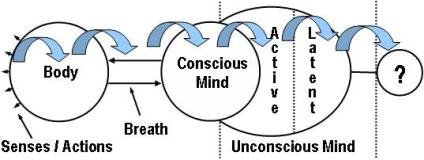THE EIGHT RUNGS OR LIMBS:
The art and science of Yoga is systematically described in eight (ashta) rungs, steps, or limbs (anga). Thus, this section of the Yoga Sutras is also called Ashtanga Yoga. The eight rungs of Yoga are summarized in sutra 2.29, and explained in the next section (2.30-2.34). Subsequent sutras further describe the benefits and methods of working with those eight rungs (2.35-2.45, 2.46-2.48, 2.49-2.53, 2.54-2.55).
1) Yama: codes of restraint, abstinences (2.30, 2.31)
2) Niyama: observances, self-training (2.32)
3) Asana: meditation posture (2.46-2.48)
4) Pranayama: expansion of breath and prana (2.49-2.53)
5) Pratyahara: withdrawal of the senses (2.54-2.55)
6) Dharana: concentration (3.1)
7) Dhyana: meditation (3.2)
8) Samadhi: deep absorption (3.3)
THE EIGHT RUNGS ARE FOR DISCIMINATIVE ENLIGHTENMENT:
The reason for practicing the eight rungs of Yoga (2.29) is to develop attention as the tool for discriminative knowledge, which is the means to discriminative enlightenment and liberation. It means using razor-like attention (3.4-3.6) to separate the seer and the seen (2.17), so as to break the alliance of karma (2.12-2.25), and to get past the four mistakes of ignorance, or avidya (2.24-2.25), which are: 1) confusing the temporary for the eternal, 2) the impure for
the pure, 3) misery for happiness, and 4) the false self for the true Self (2.5). Resulting from this systematic discrimination, the seer or Self is eventually experienced in its true nature (1.3).
DISCRIMINATION ALLOWS SUBTLER INTROSPECTION:
This one-pointed attention and discrimination, which comes from the practice of the eight rungs, is used for examining, exploring, and attenuating the colorings of the subtle impressions of the mind field (2.10), so as to go beyond, inward to the pure, eternal center of consciousness.
THE FIRST FIVE RUNGS SHARPEN THE RAZOR:
If it is razor-like attention that is the tool for discrimination, then it is the first five rungs of the Yoga Sutras which are honing the edge of that razor. Then, the finer, sharpened tool is the last three rungs, which are concentration, meditation, and samadhi, which are collectively called samyama (3.4).
Please also see the articles:
Coordinating the Four Functions of Mind
http://www.swamij.com/fourfunctionsmind.htm
Yoga Sutras:
http://www.swamij.com/yoga-sutras.htm
Attaining Yoga or Union:

Yoga or "Union" is attained by first training, balancing, and purifying each of the aspects of our being individually, and then systematically receding attention inward through those levels, expanding so as to experience the state of Union, Yoga, Samadhi, or Turiya.


